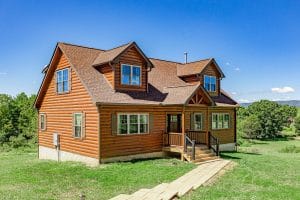Log cabins are a timeless blend of natural beauty and cozy comfort. The charm of exposed logs, rustic aesthetics, and connection with nature makes them highly desirable as both vacation retreats and full-time homes. However, their natural construction also makes them vulnerable to the elements. Without proper seasonal maintenance, issues like water damage, insect infestations, and structural wear can quickly escalate. This guide provides expert advice on seasonal maintenance for log cabins, helping you prevent damage and extend the life of your home year-round.
Spring Maintenance: Preparing for Growth and Moisture
Spring is a crucial time for log cabin care. After the harsh winter months, your cabin may have accumulated snow, ice, and debris that can damage logs, gutters, and the roof. Begin by thoroughly inspecting the exterior logs for cracks, rot, or insect activity. Check where logs meet the foundation, as winter moisture may have caused small gaps or water stains.
Clean gutters and downspouts to ensure proper drainage. Remove any debris, fallen branches, and leaves around the cabin to prevent moisture from pooling near the foundation. Spring is also ideal for applying a fresh coat of log stain or sealant, especially in areas exposed to heavy sun or rainfall. Maintaining a proactive approach during this season protects your logs from water damage and promotes longevity.
Summer Maintenance: Combating Sun and Heat
Summer introduces its own challenges for log cabins, primarily related to heat, sunlight, and pests. UV rays can fade and damage the exterior logs, so inspect your cabin for discoloration or cracks. Gently power wash the logs with a mild detergent to remove dirt, pollen, and mildew. Avoid harsh chemicals that can harm the wood.
Pest control is particularly important during summer. Insects such as termites, carpenter ants, and wood-boring beetles thrive in warm weather. Remove debris, firewood piles, and overgrown vegetation near the cabin to minimize infestation risks. Applying insect-repelling treatments or natural deterrents to logs further protects your cabin. Summer maintenance also includes inspecting the roof for loose shingles or damaged metal panels and checking that gutters are free of blockages after seasonal storms.
Fall Maintenance: Preparing for Cold and Moisture
As temperatures drop in fall, it’s time to prepare your cabin for winter. Inspect the roof, chimney, and attic for leaks or structural issues. Replace or repair damaged shingles and ensure that flashing is intact to prevent water infiltration. Clear gutters of leaves and debris to avoid clogs that could lead to ice dams in winter.
Seal gaps around windows, doors, and log joints to improve insulation and prevent drafts. Check outdoor plumbing and irrigation systems for leaks and drain them as needed to protect against freezing. Fall maintenance also involves trimming tree branches that could fall under heavy snow or ice, potentially damaging the cabin. By taking these preventive steps, you ensure your log cabin remains safe and energy-efficient during colder months.
Winter Maintenance: Protecting Against Snow and Cold
Winter can be the most challenging season for log cabins, especially in areas with heavy snowfall or ice. Accumulated snow on the roof can cause structural stress, so regularly remove excess snow with proper tools to avoid damage. Clear pathways and areas around the foundation to prevent water from melting snow pooling against logs.
Protect your pipes from freezing by insulating exposed plumbing and using heat tape where necessary. For cabins with wood-burning stoves or fireplaces, ensure the chimney is clean and functioning efficiently to prevent fire hazards and maintain heating performance. Winter maintenance also includes monitoring interior humidity levels, as excessive moisture can lead to mold, mildew, and log contraction or cracking.
General Maintenance Tips Throughout the Year
While seasonal maintenance is essential, some tasks should be performed year-round to keep your log cabin in peak condition:
-
Inspect Logs Regularly: Check for cracks, rot, or insect activity every few months. Address minor issues promptly with chinking or wood sealant.
-
Maintain Gutters and Drainage: Keep gutters clean and ensure water is directed away from the foundation to prevent moisture damage.
-
Control Pests: Remove wood debris and vegetation near the cabin, and apply safe insect treatments as needed.
-
Manage Indoor Humidity: Use dehumidifiers and ventilate areas prone to moisture, such as bathrooms, kitchens, and basements.
-
Monitor Windows and Doors: Check seals, apply weatherstripping, and replace worn caulking to prevent drafts and moisture infiltration.
FAQs About Seasonal Log Cabin Maintenance
Q1: How often should I apply log sealant?
A: Typically every 3 to 5 years, but areas exposed to harsh sun or heavy rainfall may require more frequent treatment.
Q2: Can I perform all seasonal maintenance myself?
A: Many tasks can be done DIY, but professional inspections every few years help identify hidden issues and ensure safety.
Q3: How can I prevent insect infestations naturally?
A: Keep areas around the cabin clear of debris and vegetation, use borate-based wood treatments, and regularly inspect logs for signs of pests.
Q4: What is the best way to protect my cabin during winter?
A: Remove snow from the roof and around the foundation, insulate pipes, and maintain proper indoor humidity.
Q5: How important are gutters for log cabin maintenance?
A: Extremely important. Gutters direct water away from logs and the foundation, preventing rot, mold, and structural damage.
Conclusion
Maintaining a log cabin requires attention to detail, seasonal planning, and proactive care. By addressing spring moisture, summer heat, fall preparation, and winter challenges, you can prevent costly damage and preserve your cabin’s natural beauty. Regular inspections, proper log treatments, pest control, and water management are key elements of a comprehensive maintenance routine. Following this seasonal maintenance guide ensures your log cabin remains safe, comfortable, and visually appealing for years to come, letting you fully enjoy the charm and tranquility of your rustic retreat.



